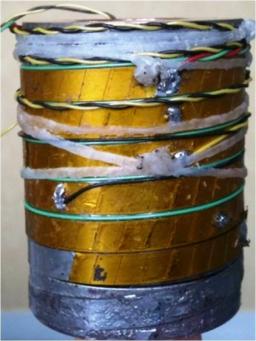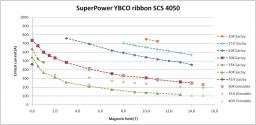
Small coil made from a superconducting YBCO Superpower SCSC 4050 ribbon and used to measure the critical current.
Physicists and engineers have always been intrigued by high transition temperature superconducting materials ever since their discovery in 1986 by Bednorz and Muller. Not only is their ability to transport an intense electrical current in the superconducting state preserved at temperatures in excess of 60 K (for certain materials) but, most importantly, they keep their superconducting properties under an induced field of 30 T providing they are kept at the temperature of liquid helium. Using these materials, it becomes possible to make superconducting magnets capable of either operating between 30 and 40 K, or of generating magnetic fields of 30 T.
Following the modernization of the test stations in order to carry out tests on these new superconductors, SACM began a series of tests to characterize the superconductor Bi2212 as part of a program led by EFDA. This program provided the opportunity to develop a round strand of Bi2212 containing 666 individual filaments. The development project was carried out jointly by an industrial manufacturer and the Institute for Research on Magnetic Fusion at Cadarache.
Two new projects were launched. One was a project funded by the ANR to study the energy storage system in a superconducting magnet with a high specific energy density. The other was a European funded project to manufacture a dipole insert to be installed in an Nb3Sn dipole. Both these projects will study new YBCO superconducting materials available in the form of ribbons.
The SUPERSMES development of the Superconducting Magnetic Energy Storage project (SMES) aims to produce a conceptual design for a magnetic system capable of storing 20 kJ/kg. The current record for a system of this type is around 13.5 kJ/kg. The project also aims to include the manufacture of qualification prototypes in order to qualify the most critical components of such a magnetic system, especially the superconductor. The project is being carried out in collaboration with the LNCMI and LGEP laboratories at CNRS, Grenoble, and the industrial manufacturer Nexans.
The European EuCARD project aims to construct a dipole insert generating a field of 6 T to be installed in a Nb3Sn magnet to bring the total field up to 20 T. Several prototypes will be built to study the propagation of the resistive transition in these new superconducting materials.
• superconducting magnet physics and technology › Developments for instrumentation
• Accelerators, Cryogenics and Magnetism Division (DACM)
• LCSE


